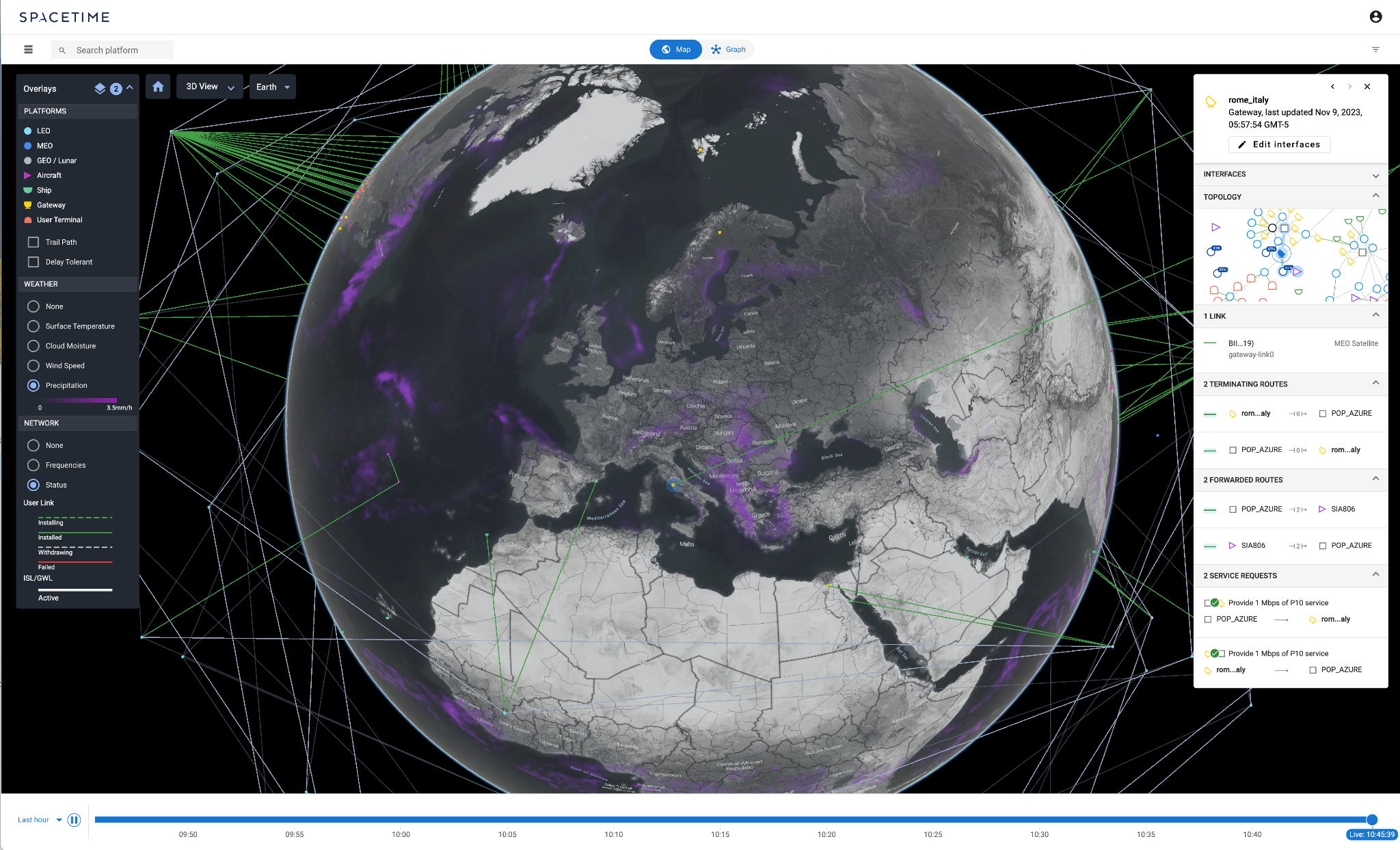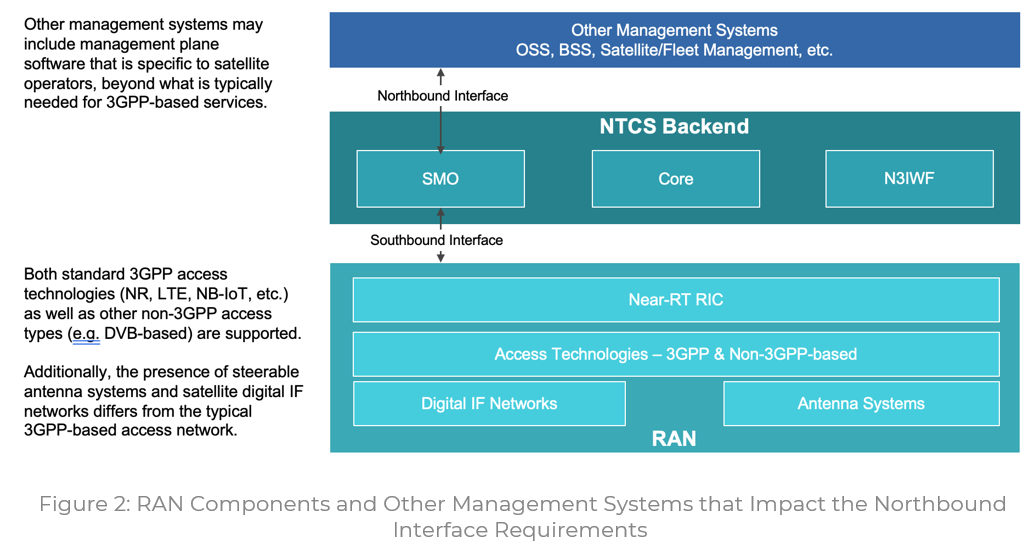
-
StatusOngoing
-
Status date2024-01-22
-
Activity Code3A.187

The overall objective of this activity is to develop a fully integrated 5G/6G NTN orchestration platform, leveraging novel NTN additions to the O-RAN management interfaces, which is capable of managing networks deployed across GEO as well as NGSO constellations, including those that route through inter-satellite links (ISLs).
Leveraging Spacetime, Aalyria’s existing, production-validated platform for the orchestration of non-3GPP aerospace networks, the project starts by identifying, implementing, and testing modifications to the existing suite of O-RAN interfaces. For this, Aalyria’s extensive experiences in orchestrating large-scale satellite networks will be utilised to propose an informed view on the necessary changes to the interfaces, in order to make them capable of supporting 5G operations in a 3D NTN deployment.
Finally, the extended interfaces will be integrated into Spacetime, such that the orchestrator can produce actionable commands which could be provisioned through them, and whose contents would be packaged according to principles the O-RAN Alliance has defined. The target final product of Aalyria’s cooperation with ESA is a commercial-grade 5G NTN-capable SMO solution that is ready for deployment in operator networks.
Non-Terrestrial Networking operates at a scale and distances that current networking standards were not designed for. While the 3GPP release 16 and 17 standards define the support for dynamic, directional, steerable-beam network equipment topologies, such as terrestrial Integrated Access & Backhaul (IAB) networks and non-terrestrial networks, there are still significant steps to align their support with O-RAN management interfaces.
Driving industry-wide alignment on changes of this scale takes a significant amount of time. As members of multi-party industry consortia, it is critical that Aalyria leads the way on its view on the necessary changes to be proposed to the O-RAN Alliance.
Open Radio Access Network (O-RAN) allows interoperation between cellular network equipment provided by different vendors. By extending the O-RAN interfaces to support 5G/6G non-terrestrial networking (NTN) capabilities, this project enables O-RAN compatible systems to support TN and NTN steerable-beam mesh telecommunications and for NTN carriers to co-operate to maximise user reach.
The project activities include adoption of these draft 5G/6G NTN O-RAN interfaces into Aalyria’s Spacetime network service orchestration platform; although, as an open standard, O-RAN interfaces can be used by any operator or platform for free. Existing liaison agreements with GSMA (which represents the world’s mobile network operators), TIP Non-Terrestrial Connectivity Solutions (NTCS), and the O-RAN Alliance through TIP OpenRAN group’s established partnerships allow this project to influence the necessary changes to standards worldwide.
Wide scale adoption of 5G/6G NTNs will boost many more technologies built on top of pervasive mobile data; examples range from connectivity in every step of the global transportation & shipping industry to smart farming in rural regions to better earth observation data to improving real time forest fire fighting.
Acting as Non-Terrestrial Connectivity Solution (NTCS) Backend software for 5G/6G NTN network operators:
-
Spacetime can support network planning tool interfaces for network operators to evaluate inclusion of both directional mesh and non-terrestrial networking elements in their capacity planning and coverage solutions.
-
Spacetime can allow terrestrial network operators to leverage their own terrestrial network backend systems and spectrum to make transient use of HAPS and/or satellites as part of their RAN. This alleviates the need for user and subscriber data to flow through a third-party core.
-
Spacetime will enable regulators and network operators to define more efficient RF spectrum sharing policies, thereby increasing the total number of directional mesh and non-terrestrial networks that can operate in each region.

The Non-Realtime (Non-RT) RAN Intelligent Controller (RIC) and service management and orchestration (SMO) layer in the O-RAN 5G architecture provide capabilities for control and management of both the RAN and backhaul mesh networks. The Non-RT RIC enables the execution of rApps that contain the real algorithms and intelligence for resource management and monitoring.
The xApps and rApps use the software interfaces of their respective RICs to obtain information about the network elements and their parameters, and to affect control over them. The intended cases are management processes that do not require tight (<100 msec) control loop latencies, which are suitable to perform functions like interference management, radio resource management, among other applications.
In addition to basic 5G NTN RAN support, it is important for RIC-hosted x/rApps to have abilities for directing the physical link topology, routing, and radio resource management of dynamic, directional steerable beam networks. Support for motion of platforms and beams, directionality of antenna beam patterns, millimetre wave, and optical wireless signal propagation requires us to extend the information base of software defined networking systems to provide the set of parameters needed to model RF propagation rApps such as those performing Radio Resource Management and other tasks.
Q1 2024
-
Publish proposed O-RAN interface changes to enable TIP NTCS use cases.
-
Preliminary design for Spacetime system changes.
Q2 2024
-
O-RAN proposal revision.
-
Spacetime software updates for integration with draft 5G/6G O-RAN interfaces
Q3 2024
-
IO-RAN RIC Simulator integration
-
Introduce updated ML-based solver for Spacetime to demonstrate improved computational efficiency and scale for 5G/6G use cases.
-
Publish final reports.
⅓ of the way through the Definition Phase:
-
We have begun an internal analysis of the current structure and operational envelope of the existing O-RAN northbound and southbound interfaces. This includes decomposing their intended flows, principles and procedures, and beginning to define how we envision the specific characteristics of satellite-borne 5G NTN nodes impacting them.
-
Selected tooling for efficiency evaluation of the current faster-than-real-time solver to ensure it scales with the scope of this work.
-
Demonstrated a Spacetime instance integrated with the ESA 5G/6G Hub in Harwell UK in late 2023.



